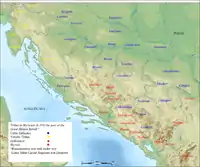Bato the Daesitiate
Bato the Daesitiate (also known as Bato of the Daesitiates[1]) was a chieftain of the Daesitiates, an Illyrian tribe which fought against the Roman Empire between 6 and 9 AD in a conflict known as Bellum Batonianum ("Bato's War").[2]
Biography
Bato was probably born between 35 and 30 BC in what is today Upper Bosnia. Bato belonged to the indigenous Daesitiates tribe,[3] whose homeland was in what is today central Bosnia, and at a critical point in time he chose to lead his people in their struggle against their Roman occupiers. From 33 BC, the Daesitiates were under Roman rule as a semi-independent peregrine civitas. The civitas of the Daesitiates was part of provincia Illyricum with its capital in Salona on the Adriatic coast. Bato was probably a member of a distinguished indigenous family, and as an adult he was probably a political and military official of the Daesitiates.

In 6 AD, the Romans planned to attack the Marcomanni in Magna Germania and for that Augustus, the Roman Emperor, ordered the mobilisation of Illyrian auxiliary forces. But in spring the same year Illyrian forces in Bosnia rebelled[4] with Bato as their leader. In the Pannonian region of Illyricum, the Breuci also rebelled. The leader of the Breuci, also named Bato, became leader of the Pannonian rebels. These two centres of resistance united in the autumn of 6 AD, and the two Batos became war-leaders of an allied rebel army.[5]
Rome sent 10 legions and the same number of auxiliaries, allies, and mercenary forces to crush the uprising. Many within the legions were Roman war veterans. The supreme commander of all Roman forces was future emperor Tiberius. Bato the Daesitiate unsuccessfully attempted to take Salona, and after he was defeated by Marcus Valerius Messalla Messallinus, the governor of Illyricum, he withdrew north to join forces with the other Bato, the leader of the Breuci. After two years of war, in the summer of 8 AD, Bato of the Breuci surrendered his forces to Tiberius on the bank of the river Bathinus (probably the river Bosna). Soon afterwards, he was captured by Bato of the Daesitiates, whose assembly put Bato of the Breuci to death. In the next year, Tiberius and his nephew Germanicus launched an operation against the Daesitiates. After fierce battles in September 9 AD, only a few days before the Battle of the Teutoburg Forest, Bato and the Daesitiates surrendered to Tiberius. It is alleged that when Tiberius asked Bato and the Daesitiates why they had rebelled, Bato was reputed to have answered: "You Romans are to blame for this; for you send as guardians of your flocks, not dogs or shepherds, but wolves." Bato spent the rest of his life in the Italian town of Ravenna.[6]
References
- The Cambridge Ancient History: The Augustan Empire, 43 B. C-A.D. 69. Cambridge University Press. 1996. ISBN 9780521224963.
Led by Bato of the Daesitiates and Bato of the Breuci they attacked Roman settlements, the colonies On the Adriatic and even penetrated to Macedonia.
- Mesihović, Salmedin (2018). Bitka za Ilirik (Battle for Illyricum): Batonian revolt (in Bosnian). Bathinvs. ISBN 9789926821746. Retrieved 30 January 2019.
- Wilkes, J. J. The Illyrians, 1992, p. 216, ISBN 0-631-19807-5. Further east the formidable Daesitiates of Central Bosnia retained their name. The great rebellion of All 6 had been led by their chief Bato, and their relatively low total of 103 decuriae likely reflects...
- Wilkes, J. J. The Illyrians, 1992, p. 207, ISBN 0-631-19807-5. The rising began among the Daesitiates of central Bosnia under their leader Bato but they were soon joined by the Breuci. The four-year war which lasted...
- Smith, Dictionary of Greek and Roman Biography and Mythology Archived June 7, 2008, at the Wayback Machine - The name of two leaders of one of the most formidable insurrections in the reign of Augustus.
- Smith, Dictionary of Greek and Roman Biography and Mythology Archived June 7, 2008, at the Wayback Machine - He sent Bato to Ravenna.
Bibliography
- Velleius Paterculus II, CX, 4–5.
- Ovidius, Ex Ponto II, I, 46.
- Suetonius, The Twelve Caesars, Tiberius 20.
- Cassius Dio, Roman History LV, 29, 2; LV, 32, 3; LV, 34, 4; LVI, 12, 2–3; LVI, 13, 2; LVI, 16, 1–3.
- Strabo Geography VII, 5, 3; and an inscription (CIL V, 03346) in Verona.